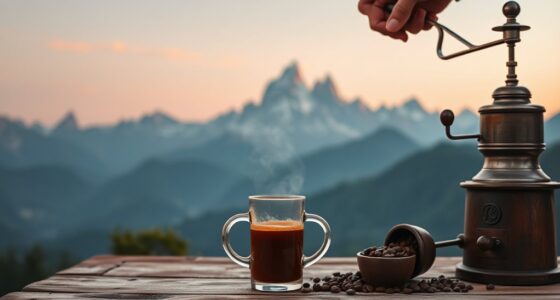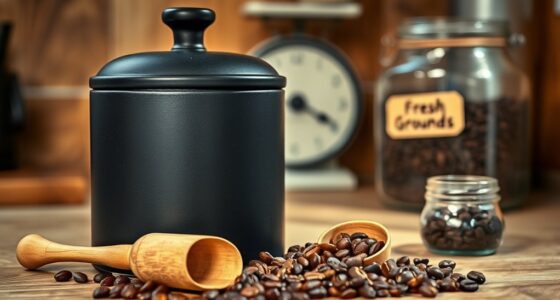To avoid common pitfalls with Arabica versus Robusta, focus on flavor profiles, caffeine content, and origin. Don’t assume all beans are of equal quality; instead, evaluate factors like processing, freshness, and sustainability. Remember that roast level and brewing methods influence taste more than bean type alone. Prices aren’t always reliable indicators of quality, so explore beyond costs. Keep an open mind and consider your personal preferences—more insights are ahead to help you choose wisely.
Key Takeaways
- Recognize that origin and processing impact flavor and quality more than just bean variety.
- Don’t assume higher-priced coffee is always better; evaluate based on origin, processing, and freshness.
- Understand that flavor profiles vary widely; Arabica is smoother, while Robusta is stronger and more bitter.
- Consider caffeine content differences; Robusta generally has double the caffeine of Arabica.
- Avoid stereotypes about brewing methods; experiment to discover what suits your taste regardless of bean type.
Overlooking the Flavor Profile Differences
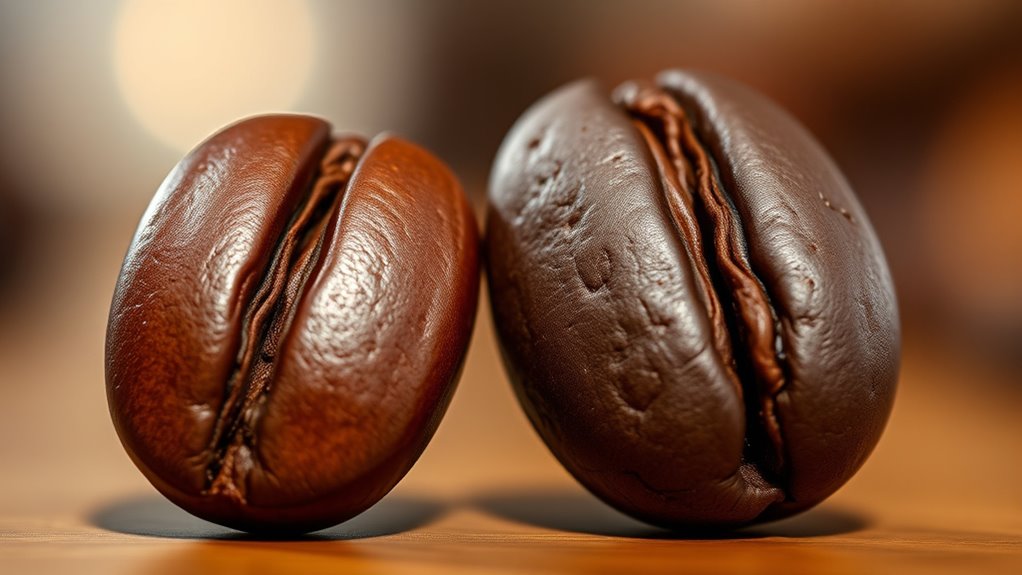
Many people focus on the physical differences between Arabica and Robusta beans but overlook how their flavor profiles set them apart. The flavor nuances of each bean influence your overall coffee experience and should guide your taste preferences. Arabica beans tend to have a smoother, more complex flavor with hints of fruit, sugar, and floral notes, making them ideal for those who enjoy a nuanced cup. Robusta beans, on the other hand, deliver a stronger, more bitter taste with earthy and woody undertones, appealing to those who prefer bold flavors. Recognizing these subtle differences helps you choose beans that align with your palate. Paying attention to flavor profile differences can greatly enhance your coffee selection process. Don’t neglect flavor profiles when selecting your coffee; understanding these nuances enhances your enjoyment and ensures a satisfying brew.
Ignoring Caffeine Content Variations
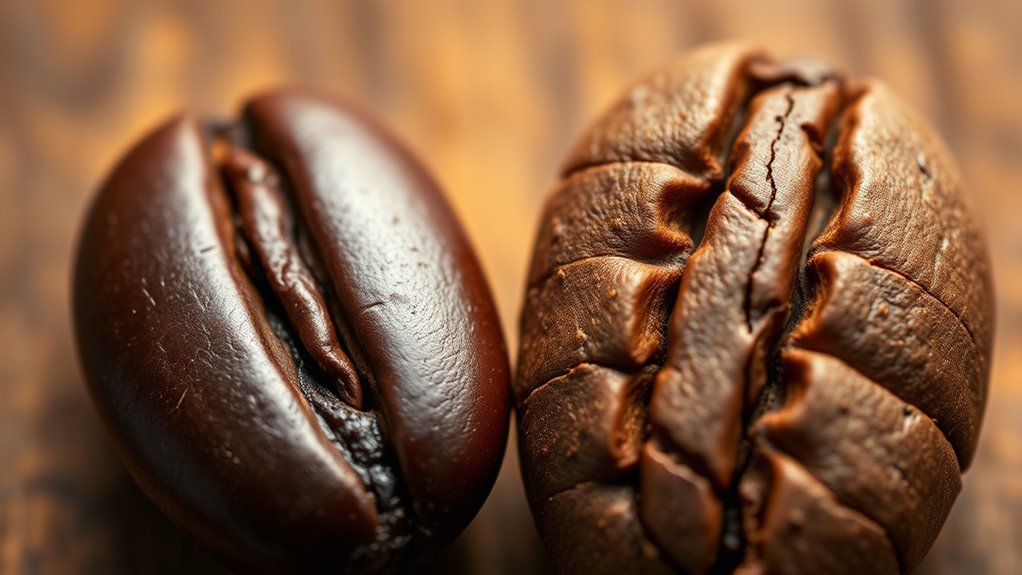
Many people overlook caffeine content when choosing their coffee, but it can considerably affect your energy boost. Robusta generally has more caffeine than Arabica, which means you’ll get a stronger jolt. Ignoring these differences might lead to unexpected effects on your alertness and stamina. Additionally, understanding caffeine variations can help you select a blend that aligns with your desired energy level and health considerations.
Caffeine Levels Differ
Have you ever wondered why some coffee drinks pack a stronger caffeine punch than others? The answer lies in the caffeine comparison between Arabica and Robusta beans. Robusta generally contains about twice the caffeine content of Arabica, leading to notable stimulant differences. This higher caffeine level makes Robusta more energizing and often more bitter, which can influence your overall coffee experience. However, it’s important to remember that these differences are averages, and variations can occur based on growing conditions and processing. Additionally, brewing techniques can impact the caffeine extraction, affecting the final caffeine content in your cup. Understanding the caffeine levels helps you choose the right bean for your desired stimulant effect. Don’t assume all coffees with similar labels have identical caffeine content—know your beans for an informed coffee choice.
Impact on Energy Boost
While caffeine content varies, the impact of Arabica and Robusta on your energy boost is also shaped by how your body responds to their unique flavors and bitterness. Robusta generally delivers a stronger caffeine effect, which can lead to higher energy levels and increased alertness. Arabica, with its smoother taste, may produce a gentler caffeine effect, resulting in a more moderate energy boost. Your individual tolerance and sensitivity influence how these coffees affect you. If you need an immediate, potent lift, Robusta might be more effective. However, if you prefer sustained energy without jitters, Arabica could be the better choice. Additionally, the tuning options available for your vehicle can enhance your driving experience, just as understanding the nuances of coffee can optimize your caffeine intake. Remember, your body’s response to each coffee’s flavor and caffeine effects ultimately determines how energized you feel.
Assuming All Arabica and Robusta Are of Equal Quality
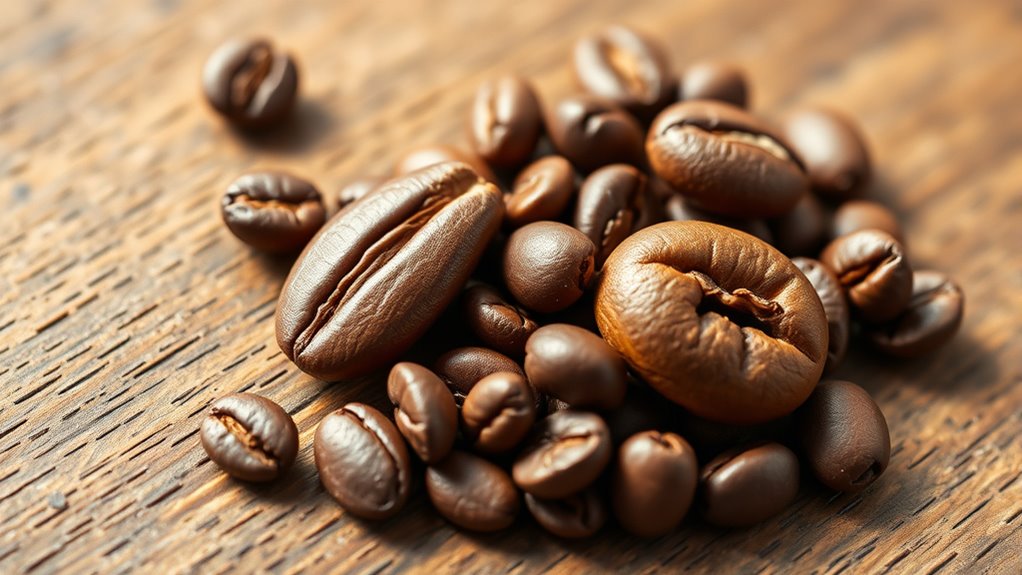
You might assume all Arabica and Robusta beans are equally good, but their origin and variety greatly affect quality. Processing and storage methods also play a big role in the final flavor and freshness. Overlooking these factors can lead to a false sense of uniformity between the two coffee types. Additionally, differences in processing technology can impact the removal of impurities and the preservation of flavor profiles, further influencing the final product.
Bean Origin and Variety
Since all Arabica and Robusta beans are considered to be of equal quality, their origin and variety become the key factors that distinguish them. The bean origin influences flavor profiles, as beans from different regions develop unique characteristics based on climate, soil, and altitude. For example, Ethiopian Arabica often offers fruity and floral notes, while Vietnamese Robusta tends to be more earthy and bitter. Coffee variety also plays a fundamental role; within Arabica, varieties like Bourbon or Typica produce distinct tastes and aromas, and the same applies to Robusta with its different strains. Understanding the bean origin and coffee variety helps you anticipate the flavor profile, ensuring you select the right beans to match your preferences. Regional diversity in flavor is often linked to resources and tools such as local climate and soil conditions, which significantly impact quality. These factors are essential in choosing quality coffee regardless of the overall grade.
Processing and Storage Methods
Processing and storage methods play a crucial role in preserving the quality and flavor of both Arabica and Robusta beans. Proper processing techniques, like drying and milling, prevent spoilage and maintain bean integrity. When it comes to storage, keep beans in airtight, moisture-proof containers away from sunlight and heat to prevent flavor degradation. Roasting techniques also influence the final taste; light roasts highlight origin flavors, while darker roasts develop bold, smoky notes. Packaging innovations, such as nitrogen-flushed bags or vacuum-sealed pouches, help lock in freshness and prevent oxidation. By paying close attention to these methods, you guarantee your beans retain their distinct qualities, whether Arabica’s delicate aroma or Robusta’s robust body, leading to a consistently high-quality brew.
Misjudging the Cost and Value Balance
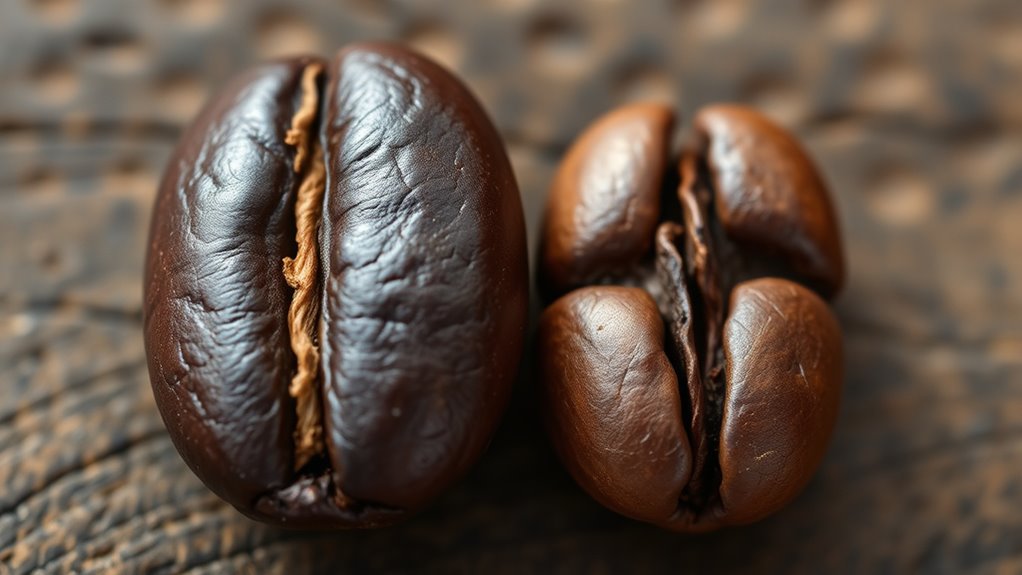
Many consumers and even some producers tend to overlook the true value behind coffee prices, often equating higher costs with better quality. A thorough cost analysis can reveal that higher-priced beans, like certain Arabicas, might not always offer better value if their flavor profile or consistency doesn’t meet expectations. Conversely, Robusta beans may be undervalued simply because of their lower price, despite offering robust flavor and cost-effectiveness for certain blends. Your value perception influences purchasing decisions; it’s essential to look beyond price tags and consider factors like processing, origin, and overall quality. Accurate evaluation ensures you get the best value for your investment, and understanding the material quality of the beans can significantly impact your overall satisfaction. Misjudging this balance can lead to overpaying for less suitable beans or missing out on affordable, high-quality options that meet your needs.
Neglecting the Growing Conditions and Origins
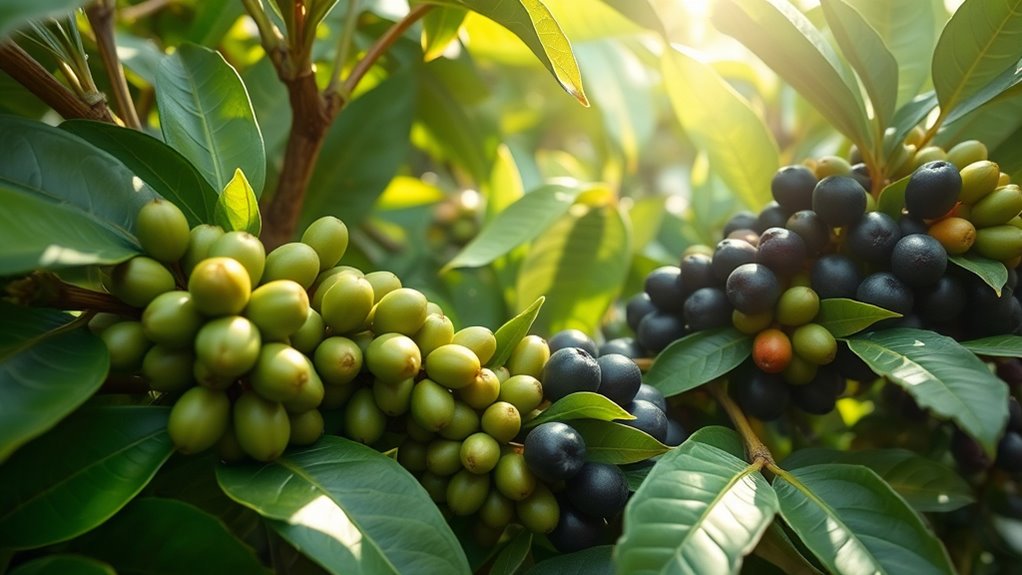
Growing conditions and origin play a crucial role in determining the flavor and quality of coffee beans, yet many overlook this when evaluating their options. Soil composition and climate influence how beans develop, affecting aroma, acidity, and overall taste. For example, Arabica thrives in high-altitude, cooler climates with rich, well-drained soil, while Robusta prefers low-altitude, warmer regions with mineral-rich soil. Recognizing these factors helps you understand why beans from Ethiopia taste different from those from Vietnam. Understanding climate influence is essential for appreciating the unique characteristics of each coffee origin.
Relying Solely on Price as a Quality Indicator

You can’t judge coffee quality just by price, since market fluctuations often distort value. A more reliable indicator is the origin of the beans, which reveals much about their flavor and quality. Relying solely on cost can lead you to overlook truly exceptional coffees.
Price Doesn’t Guarantee Quality
While higher prices often suggest better quality, they don’t always guarantee it. Relying solely on price can be misleading because factors like brand markups or market hype influence costs more than actual quality. Price transparency helps you understand what you’re paying for, but it doesn’t automatically assure quality assurance. A more expensive coffee might be priced high due to packaging or marketing rather than superior beans. Conversely, a more affordable option could offer excellent flavor and freshness. To truly assess quality, look beyond the price tag. Check for transparency in sourcing, processing methods, and certifications. Remember, a fair price that reflects genuine quality is better than simply paying more for a name or premium label. Understanding coffee quality can help you make more informed choices beyond just the price.
Market Fluctuations Skew Value
Market fluctuations can distort the true value of coffee, making price an unreliable indicator of quality. Market trends and price volatility often cause sudden swings that don’t reflect the actual quality or flavor of the beans. Relying solely on price can lead you to overlook superior beans that are temporarily undervalued. To visualize this, consider the following:
| Year | Market Trend | Price Volatility | Coffee Quality |
|---|---|---|---|
| 2021 | Rising demand | Sharp increase | High |
| 2022 | Overproduction surge | Price drops | Consistent |
| 2023 | Market correction | Fluctuations | Varies |
| 2024 | Supply chain issues | Sudden dips | Stable |
| 2025 | Global economic shifts | Price spikes | Quality varies |
This table shows how market trends and volatility can mislead your valuation, emphasizing that price alone isn’t a reliable measure of quality.
Bean Origin Matters More
Relying solely on price to judge coffee quality can be misleading because the origin of the beans often plays a more critical role. The bean origin influences flavor nuances that pricing alone can’t reveal. Beans from different regions develop distinct taste profiles due to climate, soil, and elevation. For example, Ethiopian beans often have bright, fruity notes, while Colombian beans tend to be smooth and balanced. By focusing on bean origin, you gain insight into the potential flavor complexities and quality. Price may reflect scarcity or processing methods, but it doesn’t guarantee superior flavor. When choosing coffee, consider where the beans are from to better understand their flavor nuances and make more informed, satisfying decisions.
Overgeneralizing the Suitability for Brewing Methods

Many people assume that certain coffee varieties are exclusively suited for specific brewing methods, but this overgeneralization can be misleading. While Arabica often pairs with pour-over and drip brewers, and Robusta with espresso, preferences aren’t strict rules. Your choice of brewing equipment and grind size considerably influence flavor, regardless of variety. For example, a medium grind can work well for various methods if adjusted properly. Additionally, consider how different bicycle gears can impact the quality of the brew, just as gear shifting affects a bike’s performance. Rigidly sticking to stereotypes might cause you to miss out on discovering new brewing techniques that bring out unique flavors. Instead, experiment with different grind sizes and equipment to find what works best for your taste. Don’t assume that a specific variety can only be used in certain ways—be open to exploring beyond the stereotypes.
Forgetting About Roast Level and Freshness Impact

Even if you choose the right coffee variety and brewing method, overlooking the importance of roast level and freshness can considerably diminish your cup’s flavor. The roast level determines the coffee’s flavor profile, with lighter roasts highlighting brightness and origin characteristics, while darker roasts offer bold, smoky notes. If you ignore this, you might end up with a brew that’s not balanced or suited to your taste. Freshness impact is equally critical; coffee begins to lose its aroma and flavor soon after roasting. Using stale beans results in flat, dull coffee, regardless of variety. To enjoy best flavor, pay attention to both roast level and freshness, ensuring you select beans that match your preferences and are as fresh as possible. Additionally, understanding the influence of natural materials on storage conditions can help maintain your coffee’s optimal freshness.
Failing to Consider Sustainability and Ethical Factors
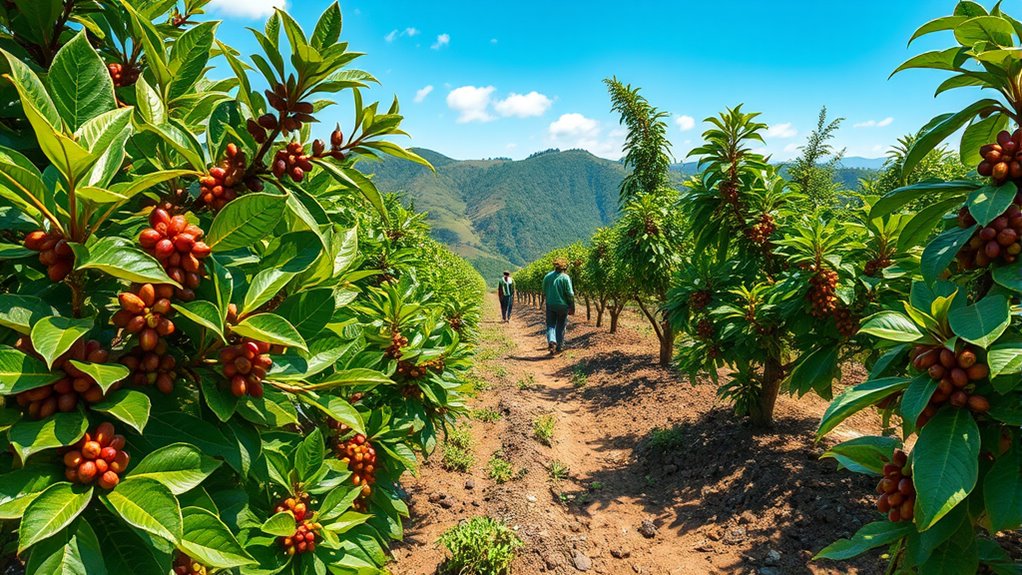
Ignoring sustainability and ethical factors can lead you to support practices that harm the environment and exploit workers, ultimately affecting the quality and integrity of your coffee. When you overlook fair trade and ethical sourcing, you risk buying beans produced under poor conditions, with little regard for environmental impact. This can also damage your reputation and reduce consumer trust. Additionally, understanding foraging practices can help you appreciate the importance of sustainable harvesting methods in preserving coffee biodiversity and ecosystems.
Ignoring Personal Taste Preferences and Experimentation

Failing to contemplate your personal taste preferences can lead you to stick with familiar coffee types, missing out on new flavors and brewing methods that might better suit your palate. By ignoring your personal preferences, you limit your flavor experimentation, preventing you from discovering unique profiles that could enhance your coffee experience. Whether you prefer the smooth, nuanced notes of Arabica or the bold, earthy qualities of Robusta, it is crucial to explore beyond your comfort zone. Experimentation allows you to find the perfect balance, roast level, and brewing style tailored to your taste buds. Additionally, understanding the personality traits of different coffee varieties can help you make more informed choices aligned with your preferences. Don’t settle for a one-size-fits-all approach—embrace flavor experimentation to truly enjoy your coffee journey and uncover what makes each variety special for you.
Frequently Asked Questions
How Do Arabica and Robusta Differ in Aroma and Flavor Complexity?
Arabica and Robusta differ markedly in aroma profiles and flavor nuances. You’ll notice Arabica offers a more complex aroma, with fruity, floral, and sweet notes that create layered flavor nuances. Robusta, on the other hand, has a stronger, earthier aroma with a harsher, more bitter flavor profile. When choosing between them, consider how their distinct aroma profiles and flavor nuances match your taste preferences for a better coffee experience.
What Are the Health Implications of Caffeine Variations in Each Coffee Type?
You should know that Arabica typically has less caffeine than Robusta, which means it may pose fewer health risks like jitteriness or increased heart rate if you consume it in moderation. Higher caffeine content in Robusta can lead to more pronounced side effects, especially if you’re sensitive. Be mindful of your caffeine intake from each coffee type to avoid health issues such as insomnia or elevated blood pressure.
Can Different Growing Regions Influence the Taste and Quality of Arabica and Robusta?
Yes, different growing regions profoundly influence the taste and quality of Arabica and Robusta. Altitude effects are vital; higher elevations often produce more nuanced flavors in Arabica, while lower altitudes favor Robusta’s robustness. Soil influence also plays a role, with rich, volcanic soils enhancing flavor complexity. You’ll notice these factors shape the beans’ aroma, acidity, and overall profile, making regional origin essential when choosing your coffee.
How Does Roasting Level Affect the Flavor Profile of Arabica Vs Robusta?
Imagine unfastening a secret flavor hidden within your coffee—roasting level dramatically shapes this. Light roasts preserve the bright, nuanced notes of Arabica, while darker roasts intensify Robusta’s bold, earthy tones. Your choice of roasting techniques and timing during coffee bean harvesting reveal subtle differences, transforming each sip into a sensory journey. The deeper the roast, the more complex the flavor, inviting you to explore every nuance in your cup.
Are There Environmental Benefits Associated With Choosing One Over the Other?
Choosing Arabica over Robusta often supports sustainable farming because Arabica plants typically require less water and thrive in higher altitudes, promoting water conservation. Robusta, on the other hand, is hardier and more resistant to pests, which can reduce the need for chemical treatments. By selecting Arabica, you help promote environmentally friendly practices, while Robusta’s resilience can also contribute to sustainable farming in regions with limited water resources.
Conclusion
Think of choosing between Arabica and Robusta like selecting a paintbrush for your masterpiece. If you ignore the brush’s bristle type or the paint’s hue, your artwork might fall flat. By understanding the nuances—flavor, caffeine, quality, and origin—you’ll craft a perfect cup that reflects your unique palette. Don’t settle for a one-size-fits-all canvas; explore and experiment to reveal your coffee’s true potential.




